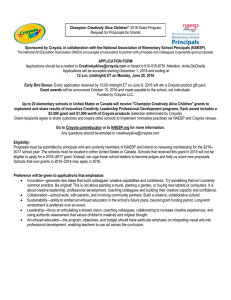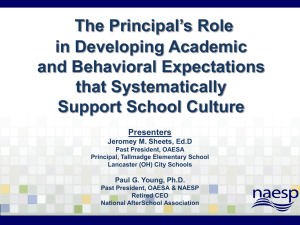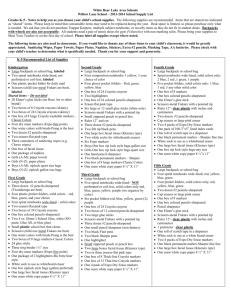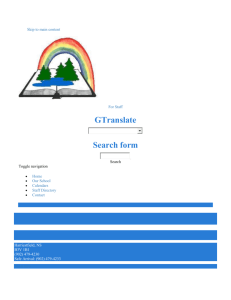Applications
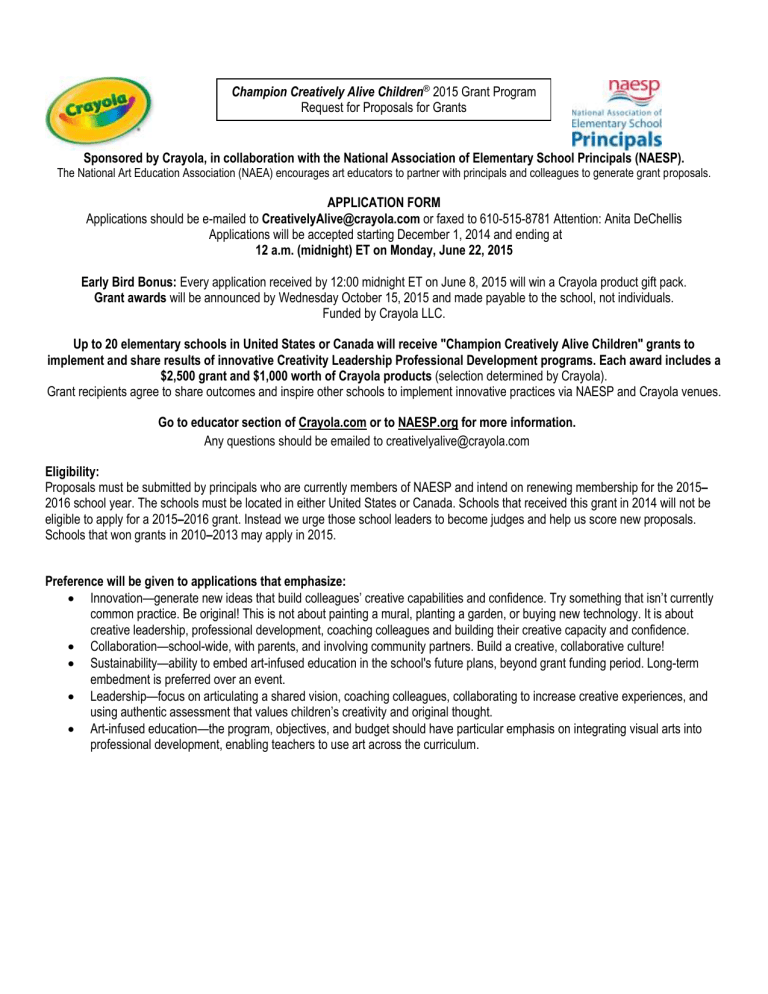
Champion Creatively Alive Children ® 2015 Grant Program
Request for Proposals for Grants
Sponsored by Crayola, in collaboration with the National Association of Elementary School Principals (NAESP).
The National Art Education Association (NAEA) encourages art educators to partner with principals and colleagues to generate grant proposals.
APPLICATION FORM
Applications should be e-mailed to CreativelyAlive@crayola.com or faxed to 610-515-8781 Attention: Anita DeChellis
Applications will be accepted starting December 1, 2014 and ending at
12 a.m. (midnight) ET on Monday, June 22, 2015
Early Bird Bonus: Every application received by 12:00 midnight ET on June 8, 2015 will win a Crayola product gift pack.
Grant awards will be announced by Wednesday October 15, 2015 and made payable to the school, not individuals.
Funded by Crayola LLC.
Up to 20 elementary schools in United States or Canada will receive "Champion Creatively Alive Children" grants to implement and share results of innovative Creativity Leadership Professional Development programs. Each award includes a
$2,500 grant and $1,000 worth of Crayola products (selection determined by Crayola).
Grant recipients agree to share outcomes and inspire other schools to implement innovative practices via NAESP and Crayola venues.
Go to educator section of Crayola.com or to NAESP.org for more information.
Any questions should be emailed to creativelyalive@crayola.com
Eligibility:
Proposals must be submitted by principals who are currently members of NAESP and intend on renewing membership for the 2015–
2016 school year. The schools must be located in either United States or Canada. Schools that received this grant in 2014 will not be eligible to apply for a 2015–2016 grant. Instead we urge those school leaders to become judges and help us score new proposals.
Schools that won grants in 2010–2013 may apply in 2015.
Preference will be given to applications that emphasize:
Innovation—generate new ideas that build colleagues’ creative capabilities and confidence. Try something that isn’t currently common practice. Be original! This is not about painting a mural, planting a garden, or buying new technology. It is about creative leadership, professional development, coaching colleagues and building their creative capacity and confidence.
Collaboration—school-wide, with parents, and involving community partners. Build a creative, collaborative culture!
Sustainability—ability to embed art-infused education in the school's future plans, beyond grant funding period. Long-term embedment is preferred over an event.
Leadership—focus on articulating a shared vision, coaching colleagues, collaborating to increase creative experiences, and using authentic assessment that values children’s creativity and original thought.
Art-infused education—the program, objectives, and budget should have particular emphasis on integrating visual arts into professional development, enabling teachers to use art across the curriculum.
Champion Creatively Alive Children ® 2015 Grants
Introduction
Art-infused education helps students develop 21st century skills in critical thinking, creativity, collaboration and communication. In order to reach their full potential and grow into self-motivated learners, children’s natural curiosity and explorative spirit must be nurtured.
Crayola shares principals’ commitment to nurturing creatively alive children and using art-infused education to increase student engagement and learning. Art-infused education increases when a collaborative leadership team builds colleagues’ creative capabilities and confidence. We look forward to partnering with school Creative Leadership Teams on innovative ideas that will strengthen and spread educators’ creative capacity and the increase of art-infused education school-wide. Together we can bring colorful wings to the invisible things that grown in the hearts and minds of children.
At Crayola and NAESP we believe…
in the power of children’s original thought.
art-infused education engages students and results in robust, memorable learning.
children are empowered by creative leaders.
it takes a visionary leadership team to enhance a school’s creative collaborative culture.
“what if…?” is a great question that makes leaders explore new possibilities and implement change.
What if School Creative Leadership Teams…
…served as Chief Creative Officers in the school, responsible for increasing the creative capabilities and confidence of teachers, as well as students?
…wove art and creative thinking experiences across the entire learning community?
…used art-infused education to implement Common Core and the new National Core Arts standards?
…developed comprehensive performance assessments that value students’ creativity and original thought?
…established a collaborative, creative culture that builds 21 st century skills?
Submissions are not limited to the “what if…” ideas listed above. We encourage an original “what if…” that addresses your school’s needs.
Grant Funding:
Up to 20 elementary schools in the United States or Canada will be selected to receive Champion Creatively Alive Children grants to develop school Creative Leadership Teams that deliver professional development and document the impact increased school-wide artinfused education has on student outcomes. Each selected school will receive a $2,500 monetary grant and $1,000 worth of Crayola products. Grant recipients will share outcomes and inspire other schools to implement these innovative practices via Crayola and
NAESP venues.
Each grant application must:
be received by 12 a.m. (midnight) ET on Monday, June 22, 2015.
be submitted by a principal who is a NAESP member and who intends to be a member during the 2015–2016 school year.
be collaboratively planned by principal and teachers, including the arts teachers.
address a “what if…” opportunity envisioning how the school’s Creative Leadership Team will increase art-infused education school-wide.
include objectives, success metrics, timeline, budget, contacts, and work plan spanning October 2015 through May 2016.
outline what will be submitted in the interim report that will be due January 2016 and final report due May 2016.
identify promising practices to share with other schools; contribute content & photos for print and/or Internet stories.
agree that if funded, school will participate in a Crayola research study to help document the impact of the program (entire school faculty agree to complete a short survey pre- and post- the grant initiative)
agree that Crayola and NAESP may use, copy, and redistribute the promising practices, including but not limited to the application, interview notes, interim and final reports, lesson plans, professional development plans, rubrics, documents, photographs, illustrations, and digital media submitted in connection with the grant, for the purposes of promoting art-infused education and publicizing/advertising the program.
Schools whose proposals are selected will receive notification that they are finalists. Finalists must provide signed photograph/filming permission forms for all students and faculty (see attached form) and a W-9 form by October 8, 2015. Failure to submit signed forms by due date will result in forfeiting the award. An alternate finalist will be selected to receive the grant.
Champion Creatively Alive Children ® 2015 Grant Application Form
Principal Name: ________________________________ Principal E-mail: ____________________________________
Principal must be a member of NAESP and intend to be a member for the 2015–2016 school year. If not a member, please join now at www.naesp.org.
Key Contact Name (if not principal): ______________________Key Contact E-mail: (If not principal) __________________________
Name of School: _____________________________________________________School District: _________________________
County: ___________________________ School Telephone: ____________________________ Fax: _______________________
School Address: ____________________________________________________________________________________________
City, State, Zip Code: ________________________________________________________________________________________
School Grade Levels (e.g. K–6): __________ School Enrollment: ________ School Type (circle one): Urban / Rural / Suburban / Other
Grades involved in program, if not school-wide: ________
Grant application collaboration team members:
Name: Title:
Name:
Name:
Name:
Title:
Title:
Title:
(if more team members, please add their names and info)
E-Mail:
E-Mail:
E-Mail:
E-Mail:
As a part of the Champion Creatively Alive Children ® grant program, principals are required to:
implement the proposed project during the 2015–2016 school year.
submit an interim project report (due January 18, 2016) and a final report (due May 16, 2016); both will include promising practices, high-res photos, and stories to show progress and results towards success metrics. Include photographs and permission forms for any new students and faculty.
participate in a Crayola research study to help document the impact of the program.
agree that Crayola and NAESP may use, copy, and redistribute the promising practices, including but not limited to the application, interview notes, interim and final reports, documents, photographs, illustrations, and digital media, submitted in connection with the grant, for the purposes of promoting art-infused education and publicizing/advertising the program.
I.
II.
III.
IV.
V.
Champion Creatively Alive Children
PROJECT OUTLINE
® 2015 Grants
(must be filled in completely and submitted between December 1, 2014 and June 22, 2015)
Describe your “what if…” opportunity and how your school’s Creative Leadership Team will meet your school’s creative professional development needs (100-200 words or less):
Outline goals and objectives of your Creative Leadership Team’s proposal (300-400 words or less):
Define what success would look like and how you will measure the progress. Be sure to describe any ongoing assessment (100-200 words or less):
How will you identify and share Creative Leadership capacity building “promising practices” so other schools can benefit from your experiences? (100-200 words or less):
Why is your Creative Leadership proposal innovative? (100-200 words or less):
IX.
VIII.
VI.
VII.
Describe the collaboration planned for your Creative Leadership program. How will you foster collaboration within and beyond your school? (100-200 words or less):
Describe the sustainability of your proposal and how you will implement aspects of it beyond the grant funding (100-
200 words or less):
List key contacts and the role each leader of this project will play (e.g. superintendent, principal, art teachers, other teachers, budget coordinator, public relations manager, parent liaison, and community partners’ roles (museum, arts organization, library, university, etc.):
Project timeline (indicate key milestones) and describe work plan spanning October 2015 – May 2016:
Outline budget, including how this $2,500 will be used. List other resources/in-kind contributions that are being applied to this program, provided by your school/district or community.
(Note: the budget will be evaluated by how closely the planned expenditures align with the Champion Creatively Alive Children ® School
Creative Leadership Team Development Program objectives that build creative capacity and art-infused education school-wide. While some technology might be needed to implement this project, proposals that indicate the majority of grant funds would be spent on
technology are less likely to be funded.)
FREQUENTLY ASKED QUESTIONS
Briefly, what is the Champion Creatively Alive Children grant program? Up to 20 grants from Crayola to help Creative
Leadership teams that identify and deliver innovative programs that inspire educators to increase art-infused education.
What is the grant? The school will receive $2,500 and $1,000 worth of Crayola products to develop an art-infused education creative capacity-building professional development program.
When will the grants be awarded? The grant funds will be distributed by end of October 2015. Finalists are contacted by end of
September and if they submit the required W9 form and signed photo permission forms for all students and faculty by October 8,
2015, they will be grant winners. Winners will be announced on Crayola.com and NAESP.org on October 15, 2015.
Do I need to complete the attached photo permission form now? The attached photo permission form is required from
Finalists. Finalists will be notified in early October 2015. All applicants must agree to obtain and submit signed photo permission forms for each student and faculty member, if they win. However the forms are only completed and collected from Finalists.
What if my school does not have an art teacher? If the school does not have a certified Art Educator, the principal should collaborate with the person(s) designated within the school to teach the arts.
My principal is a member of the State affiliate association, but not the national (NAESP) - what do we do?
The principal must also be a national NAESP member. Nonmember principals can join now at www.naesp.org
.
What if my principal leaves during the 2015–2016 school year? The school's new principal should join NAESP.
Should our application focus on one of the "What if..." ideas outlined in the application form?
No, we encourage an original "what if..." that addresses your school's needs and opportunities!
Does the application need to focus on developing a Creative Leadership Team and does this team need to build the
school’s creative capacity? Yes. We look forward to the many innovative ways schools propose building the creative capacity of the school and increasing art-infused education. The plan should address specific needs and interests of your professional learning community. Consider how you’d create the team, craft a common vision, chart a strategic plan, change behaviors, build creative confidence, teach design thinking, align new National Arts Standards with Common Core or your state’s standards, embed creativity into the school culture, and use professional development, peer observation, and coaching to implement the plan.
What type of innovation is required? We urge that each grant application be original and not duplicate an idea that was funded in a prior year. The grant focus now emphasizes creative leadership and capacity building so don’t rely on ideas from past grant winners as clues to funding future proposals. The focus is to embed a long-term, school-wide commitment to art-infused education.
Does it have to include visual art integration? Yes. While it is fine to include more than one art form into your proposal, there should be visual art integration as part of the creative capacity building plan. In addition to visual art, you may weave dance, music, theatre, or media arts into your proposal.
What are examples of Creative Leadership capacity building?
We encourage schools to consider their unique needs and interests instead of adopting others ideas. That said, it often sparks thinking to hear of some examples: o A Creativity Professional Development plan could provide a series of workshops delivered by teacher leaders, for teacher colleagues.
For inspiration those teacher-leaders might attend a Creativity Leadership Conference with the plan of delivering similar training to teachers, school-wide. Those teacher leaders might use the Champion Creatively Alive Children workshop and video series, available for free on Crayola.com that features the stories of prior year grant winners and showcases their promising practices. o A Creative Leadership Team could partner with an arts organization or a university or museum that has expertise in art integration and jointly deliver a series of training workshops that is then followed with co-teaching or coaching sessions so the information gets embedded into classroom teachers' practices. o Some Creative Leadership Teams organize grade level creativity teams who meet monthly to share art-infused lesson ideas and provide feedback to each other on how to implement art integrated cross-curricular lessons. o Your school may be interested in engaging parents in the Creative Leadership planning process and provide creativity theme books for faculty and parents to read and discuss in book club sessions. These conversations could be enriched by guest speakers who specialize in the value of arts integration to increase student achievement. o Some schools used grant funds for substitutes so art teachers and classroom teachers had more collaboration and co-teaching time.
There is no one best way to do this. It needs to build your school’s creative capacity and identify a group of teacher leaders who will champion this effort within your school. The focus of Creative Leadership capacity building is to provide significant, sustainable professional development, not just a one-time speaker or a solo trip to a conference (if insights are not shared school-wide.) These are just examples. The funds could be used for other innovative ideas that foster art-based interdisciplinary learning.
Are Middle Schools eligible to receive a grant?
Yes, if the principal is a member of NAESP.
Are Early Childhood Programs eligible to receive a grant?
Yes, if the early childhood program is part of an elementary school program, and if that administrator is the principal of the elementary school and a member of NAESP.
What criteria are used to judge the applications?
The scoring rubric is available online for applicants to review before submitting.
